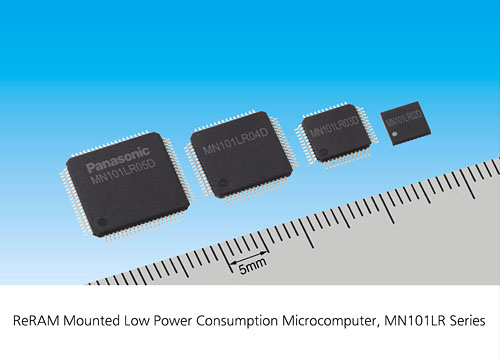Osaka, Japan - Panasonic Corporation today announced that it will start the world's first*1 mass-production of microcomputers with mounted ReRAM [1], a type of non-volatile memory, in August 2013. Through utilizing microcomputers with mounted ReRAM, it will be possible to achieve high-speed rewriting and longer operational times in battery-powered equipment, such as portable devices and security devices etc., reducing the amount of maintenance required. The first of these mass-produced products is the low power consumption 8-bit microcomputer, MN101LR series.
| Product Name | ReRAM microcomputer |
|---|---|
| Series Name | MN101LR series |
| Production Commencement | August 2013 |
| Production Scale | 1 million units per month |
In recent years, battery-driven equipment, such as portable healthcare products and security equipment for disaster and crime prevention, is becoming more common. There is a growing requirement to decrease the maintenance time for such equipment by reducing the frequency of battery replacements through extending the battery operation time. In addition, due to the high performance of the equipment, there is a need to read and write information in memory at high speed. In order to respond to such requirements, the company has introduced a microcomputer series with mounted ReRAM, featuring low power consumption and high-speed rewriting. The first part of the series comes in 16 models which feature a wide variety of peripheral functions, such as built-in LCD display control, high precision 12-bit AD converter, clock function, etc. Panasonic plans to expand the field of applications of ReRAM microcomputers to other applications, including non-contact IC cards such as electronic passports, wearable equipment connected to the cloud, and energy harvesting [2] related products.
This development has the following features:
- The use of the newly developed 0.18 µm ReRAM in microcomputers and low power-consumption processes contributes to longer operational times for customers' products.
- The high-speed, low power-consumption by byte rewriting can easily reduce the amount of EEPROM [3] previously required as part of an external attachment, thereby reducing the system cost.
- The ReRAM to be produced this time around is based on the rewriting principle of a redox reaction of a metal oxide, in which high-speed rewriting and high reliability can be achieved, making it ideal for industrial applications.
The product will be suitable for applications in portable healthcare products, such as blood-pressure meters and physical activity meters, security equipment, such as fire alarms, eco-management sensing equipment, and non-contact IC cards, such as electronic passports, etc.
*1. For ReRAM mounted microcomputers, as of July 30, 2013. Survey by Panasonic.
Explanation of Technical Terms
- [1] ReRAM (Resistive Random Access Memory)
- A type of non-volatile memory which records "0" and "1" digital information by generating large resistance changes with a pulsed voltage applied to a thin-film metal oxide. The simple structure of the metal oxide sandwiched by electrodes makes the manufacturing process easier and provides excellent low power-consumption and high-speed rewriting characteristics.
- [2] Energy harvesting
- A technology for converting a small amount of energy in the environment such as light, heat, vibrations, and electro-magnetic fields into electric power.
- [3] EEPROM (Electrically Erasable and Programmable Read-Only Memory)
- A type of non-volatile memory where the contents can be rewritten electrically.

About Panasonic
Panasonic Corporation is a worldwide leader in the development and engineering of electronic technologies and solutions for customers in residential, non-residential, mobility and personal applications. Since its founding in 1918, the company has expanded globally and now operates over 500 consolidated companies worldwide, recording consolidated net sales of 7.30 trillion yen for the year ended March 31, 2013. Committed to pursuing new value through innovation across divisional lines, the company strives to create a better life and a better world for its customers. For more information about Panasonic, please visit the company's website at http://panasonic.net/.






![[Video] TOYOTA ARENA TOKYO is born! Where next-gen sports experiences happen](http://news.panasonic.com/uploads/tmg_block_page/cover_image/18092/tat-main.jpg)
